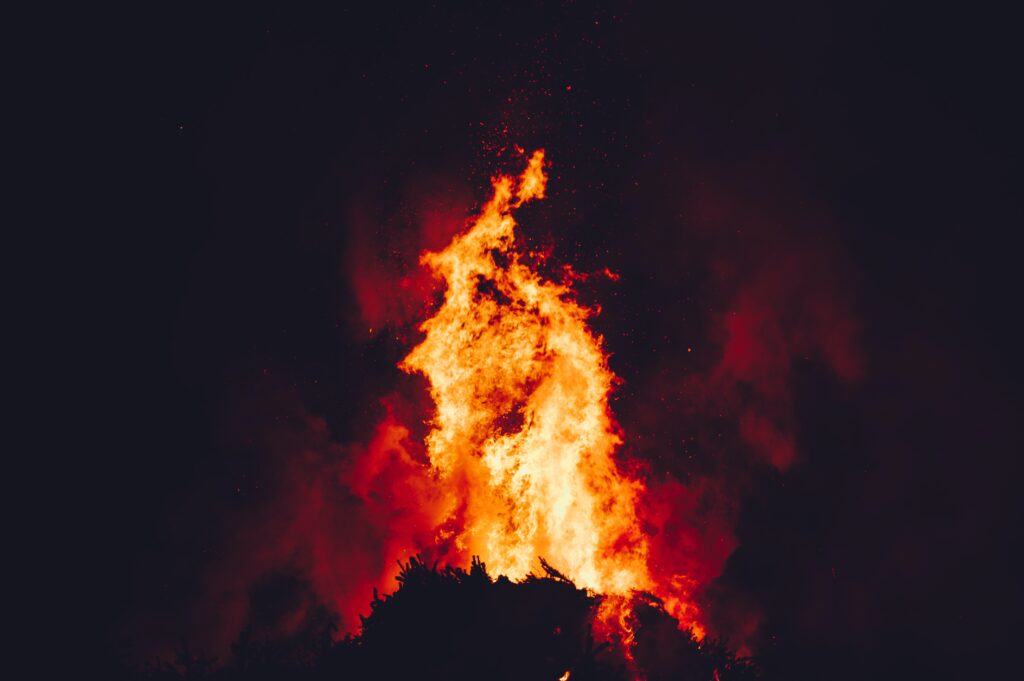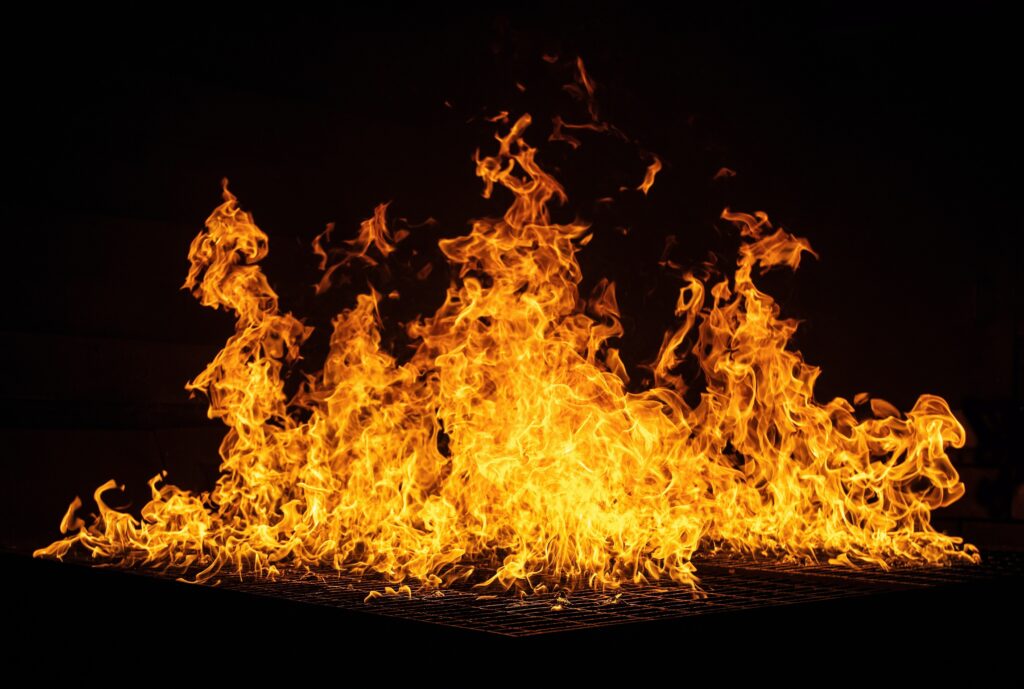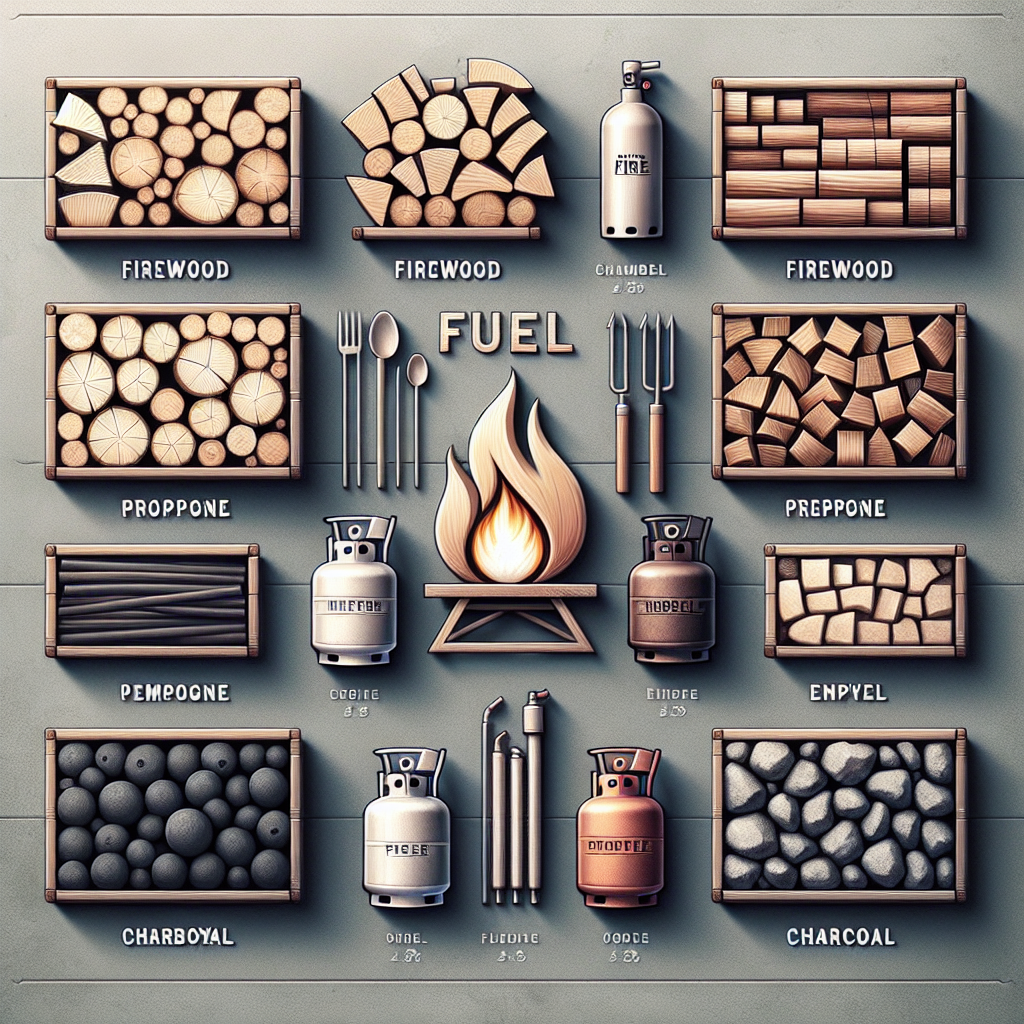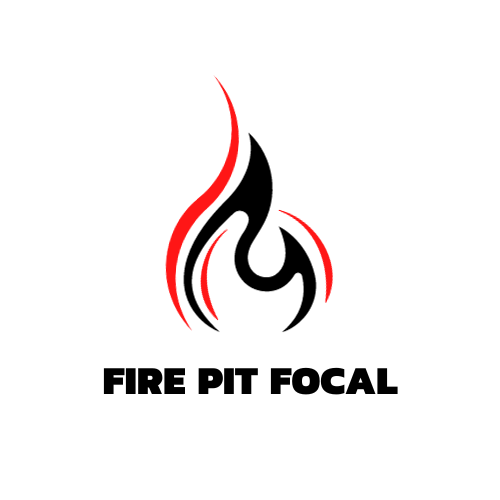Imagine sitting outside on a cool evening, gathered around a cozy fire pit with your friends, roasting marshmallows and sharing stories. But now you find yourself wondering, what types of fuel can I use in an outdoor fire pit? Well, worry not, because we’ve got you covered! In this article, we will explore a range of options for fueling your fire pit, from traditional firewood to alternative choices that offer convenience and efficiency. So grab your favorite blanket and let’s ignite your fire pit with the perfect fuel!
Wood
Wood is a classic and versatile fuel option for outdoor fire pits. There are two main types of wood you can use: hardwood and softwood.
Hardwood
Hardwood is dense and burns slowly, making it perfect for providing long-lasting heat. Common hardwoods include oak, hickory, maple, and cherry. They produce a hot and steady flame, which is ideal for cooking or enjoying a warm fire on a chilly evening. Hardwood can be a bit more expensive than softwood, but its quality and durability make it worth the investment.
Softwood
Softwood, on the other hand, burns faster and is less dense than hardwood. Popular softwood options include pine, spruce, and fir. Softwood ignites quickly and produces a crackling flame, which is great for creating a cozy and inviting atmosphere. While softwood is less expensive than hardwood, it may burn faster and require more frequent fueling.
Charcoal
Charcoal is a popular fuel choice for outdoor fire pits due to its convenience and versatility. There are two main types of charcoal you can use: lump charcoal and briquettes.
Lump Charcoal
Lump charcoal is made from natural hardwood charcoal that has been burned without additives or fillers. It produces a high heat and imparts a smoky flavor to your food when used for cooking purposes. Lump charcoal is known for its fast ignition and clean burn, making it a preferred option for those seeking authenticity and flavor in their outdoor fire pit experience.
Briquettes
Briquettes, on the other hand, are compressed charcoal blocks that have been mixed with additives and binders. They are often made from a combination of charcoal, coal, and various additives to enhance burn time and consistency. Briquettes offer a longer burn and a more consistent heat, making them a reliable choice for outdoor fire pits. They also produce less smoke and ash compared to lump charcoal, making clean-up easier.

Propane
Propane is a clean-burning fuel option that offers convenience and ease of use for outdoor fire pits. There are two main components of propane fuel for fire pits: propane tanks and propane fire logs.
Propane Tanks
Propane tanks are portable cylinders filled with pressurized propane gas. They are easily available and can be refilled or exchanged at various locations. Propane tanks offer a long burn time and can be regulated with adjustable controls, allowing you to customize the flame height and heat output according to your preference. They are a reliable option for those who want instant and consistent flames without the hassle of gathering and storing firewood.
Propane Fire Logs
Propane fire logs are designed to replicate the look and feel of a traditional wood-burning fire. They are often made from ceramic materials and are equipped with built-in burners that connect to a propane supply. Propane fire logs provide a realistic flame appearance and can be controlled with adjustable valves. They offer convenience and clean combustion, making them a popular choice for outdoor fire pits in areas where wood fires may be restricted.
Natural Gas
Natural gas is a convenient and cost-effective fuel option for outdoor fire pits that are permanently installed. There are two main components of natural gas fuel: gas line connection and natural gas logs.
Gas Line Connection
To use natural gas as a fuel for your outdoor fire pit, you will need a gas line connection. This requires professional installation to ensure safety and proper functioning. Once connected, natural gas can provide a continuous and reliable fuel source for your fire pit. It eliminates the need for propane tanks or other fuel storage, making it a low-maintenance option.
Natural Gas Logs
Natural gas logs are specifically designed to be used with natural gas fuel. They are made from ceramic materials and are equipped with burners that connect directly to the gas line. Natural gas logs offer a realistic flame appearance and can be controlled with adjustable valves. They provide a clean and efficient burn without the need for firewood or other fuel sources. However, it is important to note that natural gas fire pits require professional installation to ensure proper ventilation and safety precautions.

Gel Fuel
Gel fuel is a clean and convenient fuel option for outdoor fire pits. It is commonly used in portable fire pits or tabletop fire features. There are two main types of gel fuel: isopropyl alcohol and ethanol.
Isopropyl Alcohol
Isopropyl alcohol gel fuel is a popular choice for outdoor fire pits due to its clean-burning properties. It is a gelatinous substance that is typically packaged in cans or canisters. Isopropyl alcohol gel fuel burns cleanly with no smoke or odor, making it an excellent choice for those who want a hassle-free and low-maintenance fuel option. It also produces a bright and steady flame, providing a warm and inviting ambiance.
Ethanol
Ethanol gel fuel is another common type of gel fuel used in outdoor fire pits. It is made from corn, sugarcane, or other plant materials and is often packaged in cans or bottles. Ethanol gel fuel burns cleanly without any smoke or odor, similar to isopropyl alcohol gel fuel. It offers a long burn time and produces a vibrant and flickering flame, creating an enchanting atmosphere for outdoor gatherings or relaxation.
Pellets
Pellets are a renewable and eco-friendly fuel option for outdoor fire pits. There are two main types of pellets you can use: wood pellets and corn pellets.
Wood Pellets
Wood pellets are small, compressed cylinders made from recycled sawdust, wood chips, or other wood byproducts. They are commonly used in pellet stoves but can also be used in outdoor fire pits equipped with pellet burners. Wood pellets offer a high heat output and a consistent burn, making them an efficient fuel option. They produce minimal ash and smoke, reducing the need for cleanup and ensuring a pleasant outdoor experience.
Corn Pellets
Corn pellets are made from dried and ground corn kernels. They are primarily used in pellet stoves but can also be utilized in outdoor fire pits with the appropriate pellet burners. Corn pellets are a renewable and clean-burning fuel option that offers a steady and long-lasting burn. They produce minimal ash and emissions, making them an environmentally-friendly choice. However, it’s important to note that corn pellets may have a distinct aroma when burned, which some people may find enjoyable and reminiscent of freshly popped corn.

Coal
Coal is a traditional and efficient fuel option for outdoor fire pits, albeit less commonly used than other fuel types. There are two main types of coal you can use: bituminous coal and anthracite coal.
Bituminous Coal
Bituminous coal is a relatively soft and dense type of coal that ignites easily and produces a high heat output. It creates a bright and vibrant flame, offering a captivating visual display. Bituminous coal can be an effective fuel option for outdoor fire pits, especially in areas where it is readily available. However, it’s important to handle it with caution and follow safety guidelines due to its high carbon content and potential for emitting more smoke and pollutants than other fuel sources.
Anthracite Coal
Anthracite coal is a harder and more compact type of coal that burns hotter and cleaner than bituminous coal. It is known for its high carbon content and low smoke emissions, making it a favored option for those seeking a cleaner and more efficient burn. Anthracite coal is more difficult to ignite compared to bituminous coal but offers a longer burn time and a higher heat output. It is worth noting that anthracite coal can be harder to find and may require specialized suppliers.
Duraflame Logs
Duraflame logs are manufactured fire logs that provide a convenient and consistent fuel option for outdoor fire pits. They are made from a combination of natural wood fibers and wax, offering a clean and uniform burn.
Natural Wood Fibers
Duraflame logs are composed of natural wood fibers, including sawdust and wood shavings, which are bound together using natural additives. These wood fibers provide the bulk of the fuel and ensure a consistent burn. The natural origin of the wood fibers adds an authentic touch to the fire pit experience, allowing you to enjoy the ambiance and warmth of a fire without the need for traditional firewood.
Wax
To enhance the burn time and ignite the fire easily, Duraflame logs are also infused with wax. The wax acts as a binder, holding the wood fibers together and providing a steady source of fuel. Additionally, the wax creates a vibrant flame and helps ignite the log quickly, making it a convenient option for those who want hassle-free and instant flames in their outdoor fire pit.

Paper
Paper is an easily accessible and cost-effective fuel option for outdoor fire pits. There are two common types of paper you can use: newspaper and cardboard.
Newspaper
Newspaper is a readily available fuel source that ignites quickly and burns rapidly. It can be crumpled or rolled into tight bundles, making it easy to handle and position in your fire pit. Newspaper provides a fast-burning fire with a vibrant flame, creating an enjoyable and atmospheric experience. However, it’s important to be cautious when burning newspaper as it can produce more ash and embers compared to other fuel sources.
Cardboard
Cardboard is another paper product that can be used as fuel for outdoor fire pits. It is typically made from thick and durable materials, allowing it to burn steadily and provide a consistent heat source. Cardboard can be torn or cut into smaller pieces, making it more manageable to position in your fire pit. When using cardboard as a fuel source, it is important to ensure that it is free from any plastic coatings or adhesives, as these can release harmful fumes when burned.
Pinecones
Pinecones can be a unique and visually appealing fuel option for outdoor fire pits. They are readily available and can be collected from forests, parks, or even your own backyard. There are two main types of pinecones you can use: dried pinecones and scented pinecones.
Dried Pinecones
Dried pinecones can be used as a natural fire starter or as an addition to your fire pit for an added visual flair. They are lightweight and ignite quickly, providing a burst of flames and a crackling sound when burned. Dried pinecones can be used in combination with other fuels, such as wood or charcoal, to enhance the fire’s appearance and create a cozy ambiance.
Scented Pinecones
Scented pinecones are dried pinecones that have been infused with fragrance oils. They not only serve as a fuel source but also release a pleasant aroma when burned. Scented pinecones offer a dual purpose of providing a unique scent experience while adding to the visual appeal of your fire pit. They are perfect for creating a warm and inviting atmosphere during outdoor gatherings or simply for relaxation.
In conclusion, there are numerous fuel options available for outdoor fire pits, each with its own unique characteristics and benefits. From the traditional charm of wood to the convenience of propane and gel fuels, you have a wide range of choices to suit your preferences and needs. Whether you’re cooking a meal, enjoying the warmth on a cool night, or creating a cozy ambiance, selecting the right fuel can enhance your outdoor fire pit experience. Consider factors such as burn time, heat output, convenience, and environmental impact when choosing a fuel for your outdoor fire pit, and enjoy the crackling flames and mesmerizing glow that only a fire can provide.



